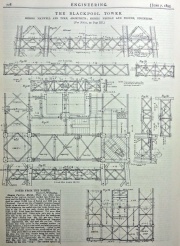Blackpool Tower












1891 Inspired by the Eiffel Tower (1889) in Paris, the Blackpool Tower Co was formed to erect a steel structure on Blackpool's seafront which was similar in appearance, but approximately half the height. The original height of the Eiffel Tower was 1024 ft (312 m), and the principal material was wrought iron.
Architects Maxwell and Tuke drew up detailed plans for the tower, which were implemented from summer 1891. The architects were assisted by the engineers Heenan and Froude; Max am Ende, a specialist in complex iron and steel structures, verified the design calculations.
1893 Charles Tuke died on the same day that the flagstaff was placed in position at the top of the tower.
Blackpool Tower was 518 feet 9 inches to the top of the flagstaff
1894 the buildings at the base, which included a circus within the four legs of the tower, were completed
The official opening was on 14 May (Whit Monday), at the time the tallest building in Britain, and the second tallest in the world. Some 70,000 people queued to go in that day.
1895 Such was Blackpool Tower's commercial success that almost immediately a site in New Brighton, Wallasey, was secured by the New Brighton Tower and Recreation Company for an even bigger structure. Maxwell and Tuke began work on the plans in July 1895 and the New Brighton Tower was built during 1897–8, opening at Whitsun 1898. The New Brighton Tower was 567 feet 6 inches tall.
1919 New Brighton Tower, having been poorly maintained during WWI, was demolished in 1919–21.
Blackpool Tower is a listed building, Grade 1.
The structural arrangement follows that of the Eiffel Tower. There are four leg structures, each comprising four box-section members with horizontal and diagonal bracing between them. The box section is 2ft 3in square at the base, reducing to 1ft at the upper floor. The Eiffel Tower's legs are appreciably flared from top to bottom, in recognition of wind forces acting over the immense height. The degree of flare is much less at Blackpool.
The design and construction were described in Engineering in 1895 [1]
- See also Blackpool Tower: Hi-Res images
See Also
Sources of Information
- ↑ Engineering 1895 Jan-Jun pages 574, 660, 727, 788
- ODNB [1]

